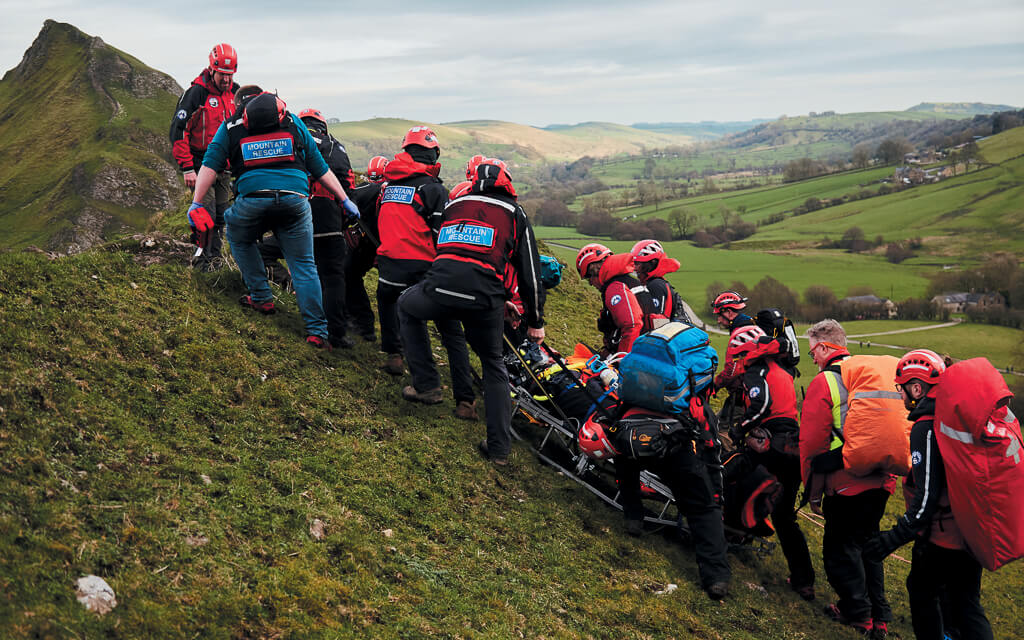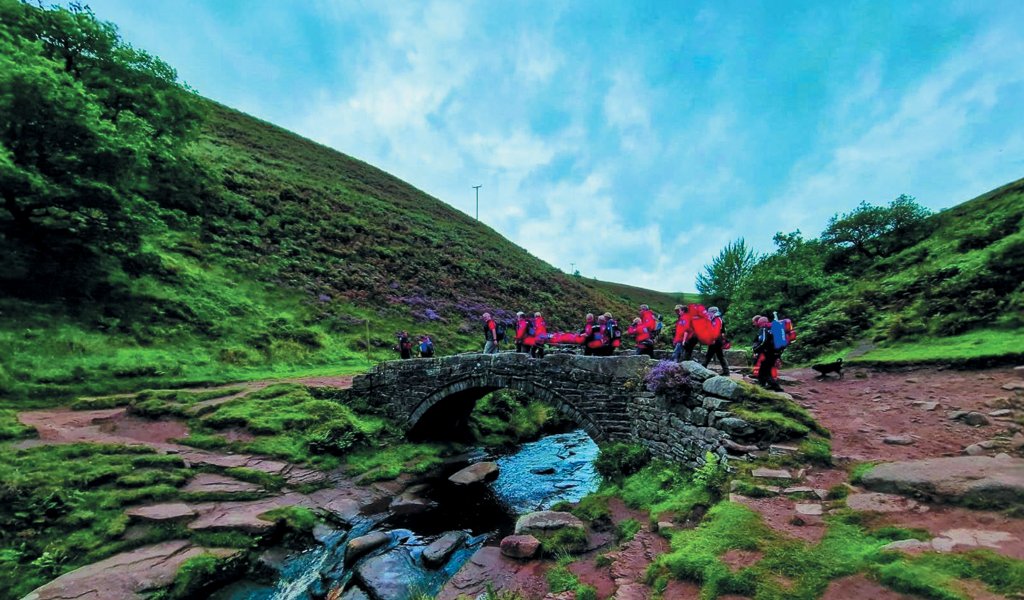One of the first of the Peak District Mountain Rescue Teams is celebrating its 60th anniversary, as Steve Brown reports.
AN injured walker or climber in the Peak District a hundred years ago would probably have waited for hours for even the news of their predicament to reach the ears of those in authority, who could then organise assistance.
With luck, the local police may have been able to gather a band of volunteers willing to turn out with rudimentary equipment and first aid. Now a simple call on a smartphone can initiate a response from a well-drilled organisation to bring life-saving treatment and state-of-the-art recovery equipment to the remotest of spots, often within an hour of such a call.
This transition has been gradual but has been driven by the increasing numbers of visitors to the Peak District National Park and by the harnessing of more sophisticated technology in communications, patient care and transportation by the selfless volunteers who continue to form the backbone of the mountain rescue teams in the area. These are people who, like many of the casualties they help, are often lovers of the hills and know well the places where they can rescue someone.
There are seven such teams covering the Peak District and affiliated to the Peak District Mountain Rescue Organisation (PDMRO); one of these is the Buxton Mountain Rescue Team and, this year, they are celebrating their 60th anniversary.
It was the death of three rover scouts on Bleaklow in March 1964, while participating in the Four Inns walk, and the problems in organising the search for and recovery of the victims which led to a radical change in how mountain rescue was set up in the Peak District. Until this time, there were a large number of organisations and clubs purporting to be able to put out a rescue team. Perhaps it was the formation of the PDMRO in September 1964 and the basic qualifications then required for affiliated teams which led to a coalescence of numbers – but the Buxton team was one of those which remained and which continues to the present day.

It was Eric Langmuir, principal of the White Hall Outdoor Centre located on Long Hill, who suggested to one of his instructors, Howard Hodgkinson, that a formal rescue team be organised in Buxton using the expertise of the centre’s instructing staff and the equipment at the centre. Howard took up the proposal, contacted various outdoor clubs in and around Buxton for prospective team members and, as team leader, set up the initial organisational meetings which took place in the Eagle pub on Buxton Market Place.
At the outset of the team’s existence, members used their own clothing, hill gear and transport but by 1972 they had raised enough money to buy an ex-military ambulance for team use, known affectionately as “The Pig” due to its lack of power steering(!), to add to the other equipment the team had gradually acquired.
In 1974, Ted Burton took over as team leader, further training continued apace and by 1976 the team had acquired sufficient medical expertise to be accepted as a Division of St John Ambulance, the first mountain rescue team in the country to achieve such an accolade.
However, by 1977, the team were in urgent need of proper accommodation to store equipment and were fortunate enough to secure a rent-free garage and storeroom in a quarry at Dove Holes. Small and cramped by today’s standards, with an ever-present film of quarrying dust, it nevertheless provided a base for the team until 1990 when its proposed redevelopment led to the team building a new base on a free 99-year lease in Dove Holes, thanks to the local Community Association and an intensive period of fundraising and publicity. It was opened in June 1990 by Diana, Princess of Wales, and remained as the team’s main base until March 2003, when a new and larger purpose-built building was opened by The Duke of York, following another successful fundraising effort. Not only were funds raised for the new building, but two team vehicles were replaced, a mobile control trailer acquired and all the team’s operational clothing was renewed. In that same year the team received the “Queens Award for Volunteers in the Community” and in 2007 the team were recognised by Derbyshire County Council with an “Excellence in the Community” award.
A significant chapter in the history of mountain rescue took place in 1971 when, after a large-scale exercise on Bleaklow, serious deficiencies were recognised in communication, organisation and within the teams themselves. Stretchers were few and far between, sleeping bags were being used instead of casualty bags and some younger team members were wandering about Bleaklow in plastic macs and shoes.
To provide a better response to incidents, four teams were recognised by the PDMRO as having the right training standards, equipment levels and all-round ability to act as “Initial Response Teams” – the first to be called in the event of a missing person – with other teams providing back-up as necessary. Buxton MRT, along with those from Glossop, RAF Stafford and Edale, were one of the four. Glossop and Edale still remain with Buxton within PDMRO, the four other teams now affiliated to the modern day PDMRO being Oldham, Kinder, Derby and Woodhead.

“Many team’s areas meet on and around the Kinder Scout plateau, so much so that there is a well-developed search plan for this popular area.”
Buxton’s area now covers some 400 square miles of countryside, from the south side of Kinder Scout down onto the Goyt Valley moors, through Macclesfield Forest and surrounds to the craggy ridge of The Roaches in the south west. Many team’s areas meet on and around the Kinder Scout plateau, so much so that there is a well-developed search plan for this popular area so that searches and rescues can be properly coordinated and smoothly conducted without undue delay.
The 1971 exercise also drew attention to serious deficiencies in communications, both in calling out team members and when on the site of an incident. This was as much a reflection of technology at the time as of human deficiencies but fortunately it was not too long before the advent of a complete radio network, including licensing and servicing, was provided for the PDMRO and rescue teams by Derbyshire Constabulary. Each team received portable handsets and a base radio and this continues to this day with the Police Control Room at Ripley being the initial receiving point for almost all emergency calls requesting ‘Mountain Rescue’ in the Peak District. Calling out team members in the 1970s still revolved around multiple calls to home telephones which could take a long time but nowadays with the advent of digital technology and the ubiquitous smartphone, a single phone call can alert all team members at once in respect of a call-out and elicit an almost instant response as to who is available and making their way to an incident. The latter has also led to the discontinuation of the interim “snatch squad” system, whereby team members from various teams who lived and/or worked near known hotspots for accidents could be quickly summoned and organised into a rescue party to effect a rapid response.
At present, the Buxton Mountain Rescue Team has 62 active members with a further 12 in training and a support team of 15-20 to take care of the many administrative tasks and fundraising needed to keep a modern team running smoothly. It takes some £45k per annum to be operational and much of that comes from public donations as well as grants from local government, private companies and community grants.
The Buxton team now has two operational bases, one at Dove Holes and one at Buxton Police Station, with two vehicles located at each, enabling rapid response to all parts. Training of new members takes up to two years, taking into account any relevant experience of first aid and hillcraft. Training sessions take place every Thursday plus occasional weekends in addition to actually attending call-outs to observe. It reflects the incredibly high standards expected of, and displayed by, the team during a call-out, working in conjunction with the emergency services, other MRTs and the air ambulance. Above all, aspirant members must learn to work as part of a close-knit team where everyone can be trusted to look out for each other in any circumstances.
Buxton MRT’s call-outs often involve searches for missing persons as well as recovery of injured walkers and climbers. Any emergency call requesting ‘Mountain Rescue’ should be made to the Police and is directed to the Derbyshire Police Communications Centre at Ripley, who then contact the Duty Network Controller for the PDMRO. The latter then decides which team/s to contact and will alert the key contacts in each. The controllers know the area and the teams well and will be aware, for instance, if any are out on exercise. Each team is then called out using just one message and those members able to respond and attend reply via the same system almost immediately. It is clearly vital to know who is attending, what equipment is being taken and from where, their time of arrival and the rendezvous spot – and modern digital communications have made this so much easier than in the early days featured earlier in this article.
Mountain Rescue Team members do not judge those who call for and receive help; they are there to afford help when it’s needed and offer it selflessly. However, they can offer advice to those going onto the moors and crags to help visitors enjoy their experiences in safety.
Neil Carruthers, team leader, says: “Plan your day, think about the weather, what clothing and equipment you need for the route you are taking. Look at the experience of your group and do your research before you set off. Accidents do happen so, remember, if you are in a remote area of the Peak District, dial 999 and ask for Police and then Mountain Rescue.






